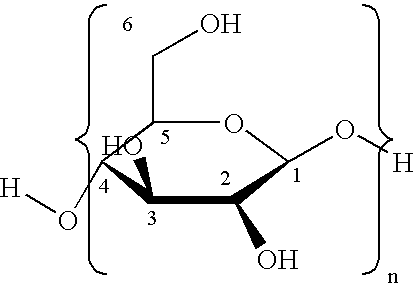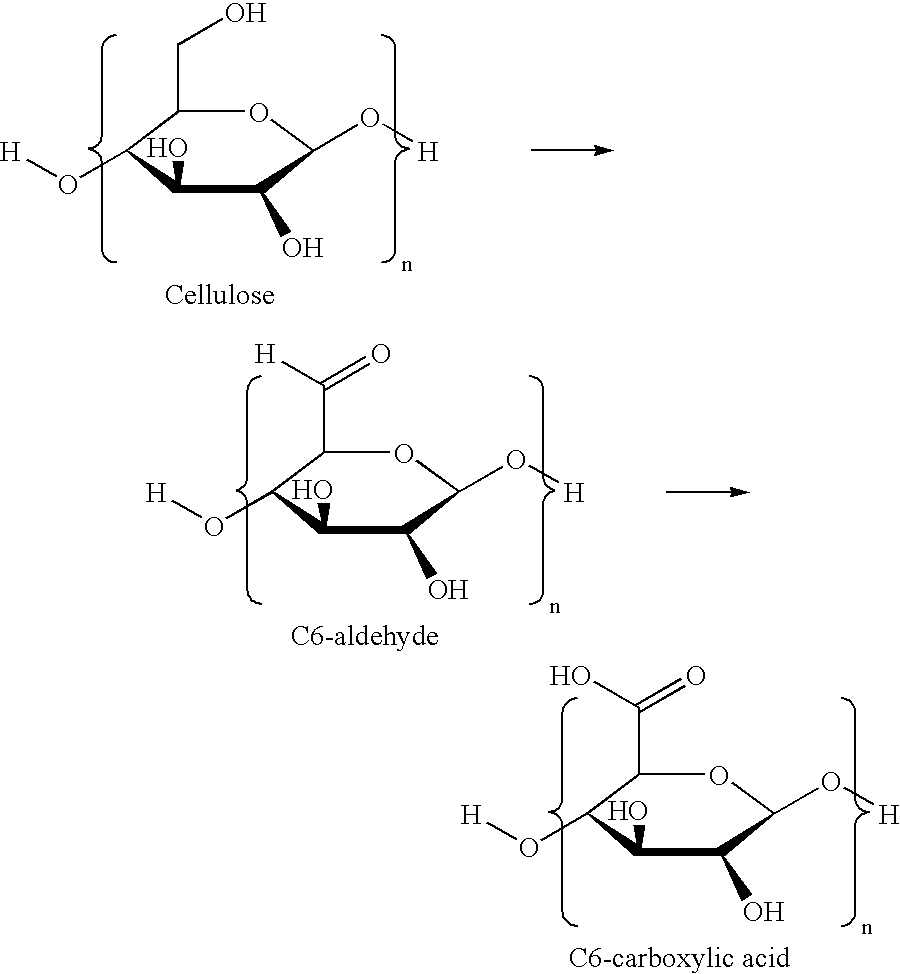Hypochlorite free method for preparation of stable carboxylated carbohydrate products
a technology hydrochlorite, which is applied in the field of hypochlorite free method for the preparation of stable carboxylated carbohydrate products, can solve the problems of poor reproduction of the tempo system, inability to obtain water soluble materials, and ambiguity
- Summary
- Abstract
- Description
- Claims
- Application Information
AI Technical Summary
Benefits of technology
Problems solved by technology
Method used
Image
Examples
example 1
Use of the Glyceryl Ketal of Triacetone Amine to Form the Primary Oxidizing Agent
[0079]The glyceryl ketal of triacetone amine (gk-TAA) is 7,7,9,9-tetramethyl-1,4-dioxa-8-azaspiro[4.5]decane-2-methanol. This is a commercially available chemical. However, it may be synthesized by reaction of 2,2,6,6-tetramethyl-4-piperidone with glycerine under strongly acidic conditions.
[0080]Part 1: 10.3 mg of gk-TAA was reacted with 2 g of a 6.7 g / L solution of ClO2 at 60° for about 2 minutes. To this was then added an additional 2 g of the ClO2 solution and the reaction continued for an additional 2 minutes at 60° C. The reaction mixture was added to 30 mL of the ClO2 solution and 60 mL water. This solution was placed in a sealable polyethylene bag and to it was then added a 45 g wet sample (10 g O.D. basis) of cellulose combined with 1 g NaHCO3. The pH at this time was 7.3. The bag with its contents was placed in a 60-70° C. water bath for 31 minutes. The oxidized pulp was drained leaving a wet m...
example 2
Investigation of Effect of Primary Catalyst Loading
[0085]A catalyst solution was made by adding 20.0 mg gk-TAA to ˜2.0 g of a solution of 6.7 g / L ClO2 at 70° C. for 1-2 minutes. The gk-TAA appeared to be totally dissolved. Cellulose was oxidized as above using 41 g (10 g O.D.) of the never dried pulp, 0.5 g NaHCO3, 75 mL water, and 14 mL of the 6.7 g / L ClO2 solution. To this was added either 0.11 g, 0.26 g, 0.50 g, or 0.75 g of the catalyst solution. These catalyst additions correspond to 0.011%, 0.026%, 0.050%, and 0.075% by weight based on dry cellulose. After 30 minutes reaction time at 70° C. the samples with the two highest catalyst usages were white in appearance, the next lower usage sample had a faint off-white color and the lowest catalyst usage sample was a light yellow. After 2 hours the samples were removed from the water bath and drained. The unwashed oxidized material was stabilized by treatment with 30 mL of the 6.7 g / l ClO2 solution and 3 g 3% H2O2. The pH was adjust...
example 3
Use of 1,3-Propanediol Ketal of Triacetone Amine to Form the Primary Oxidizing Agent
[0088]A catalyst solution was formed by reacting 10.5 mg of the 1,3-propane-diol acetal of triacetone amine and 1.5 mL of a 5.7 g / L solution of ClO2 in a sealed tube for about 1 minute. The resulting dark material readily dissolved in the liquid. Water (75 mL), 0.5 g NaHCO3, 15 mL of the 5.7 g / L ClO2 solution, and the activated catalyst solution, along with a few mL of rinse water were combined in that order. This was combined with 41 g of the wet (10 g O.D.) cellulose and mixed in a sealed polyethylene bag. The mixture was placed in a 70° C. water bath and allowed to react for 33 minutes. The slurry was acidified with 1 M H2SO4 to ˜pH 3. Then 5.0 mL of the 5.7 g / L ClO2 solution and 1.5 mL of 3% H2O2 were mixed in. The sealed bag was again placed in the 70° C. hot water bath for about 1 hour. The resulting stabilized carboxylated cellulose was washed and dried as before. Carboxyl content was measured...
PUM
| Property | Measurement | Unit |
|---|---|---|
| temperatures | aaaaa | aaaaa |
| temperatures | aaaaa | aaaaa |
| temperature | aaaaa | aaaaa |
Abstract
Description
Claims
Application Information
 Login to View More
Login to View More - R&D
- Intellectual Property
- Life Sciences
- Materials
- Tech Scout
- Unparalleled Data Quality
- Higher Quality Content
- 60% Fewer Hallucinations
Browse by: Latest US Patents, China's latest patents, Technical Efficacy Thesaurus, Application Domain, Technology Topic, Popular Technical Reports.
© 2025 PatSnap. All rights reserved.Legal|Privacy policy|Modern Slavery Act Transparency Statement|Sitemap|About US| Contact US: help@patsnap.com



